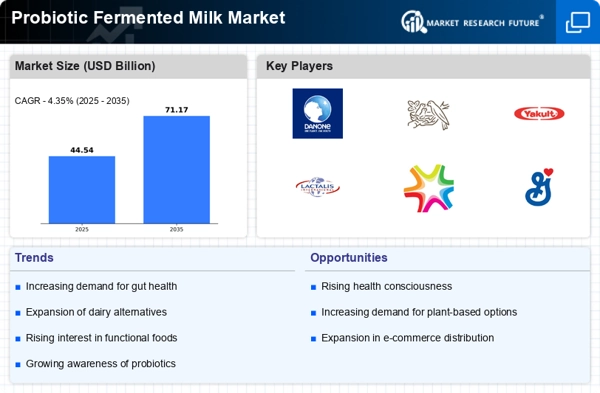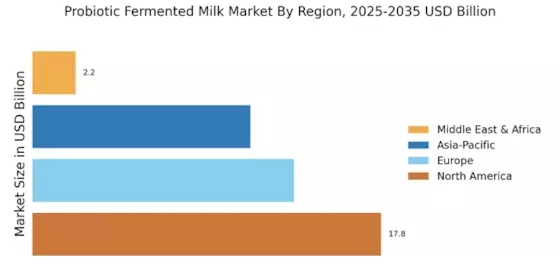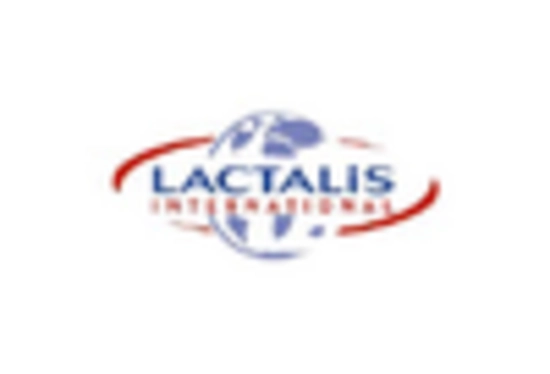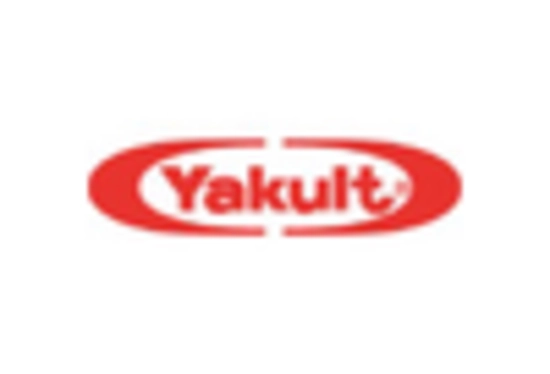Innovative Product Offerings
Innovation within the Probiotic Fermented Milk Market is a significant driver, as manufacturers continuously develop new flavors, formulations, and packaging to attract consumers. The introduction of plant-based probiotic options and lactose-free variants caters to diverse dietary preferences and restrictions. Recent market analysis indicates that innovative product offerings are crucial for capturing the attention of health-conscious consumers. As the market evolves, companies are likely to invest in research and development to create unique probiotic products that stand out in a competitive landscape. This focus on innovation not only enhances consumer choice but also drives growth within the Probiotic Fermented Milk Market.
Health Benefits of Probiotics
The increasing awareness of health benefits associated with probiotics is a primary driver for the Probiotic Fermented Milk Market. Probiotics are known to enhance gut health, boost immunity, and improve digestion. As consumers become more health-conscious, they actively seek products that offer these benefits. According to recent data, the probiotic market is projected to grow significantly, with fermented milk products being a substantial segment. This trend indicates a shift towards functional foods, where consumers prioritize health-enhancing attributes. The Probiotic Fermented Milk Market is thus positioned to capitalize on this growing demand, as more individuals incorporate probiotic-rich foods into their diets to support overall wellness.
Growing Awareness of Gut Health
The growing awareness of gut health and its connection to overall well-being is a significant driver for the Probiotic Fermented Milk Market. Consumers are becoming more informed about the role of gut microbiota in health, leading to increased interest in probiotic products. Research suggests that a healthy gut can influence various aspects of health, including mental well-being and immune function. This awareness is prompting consumers to seek out probiotic fermented milk as a means to support their gut health. As educational initiatives and marketing efforts highlight these benefits, the Probiotic Fermented Milk Market is likely to see sustained growth as more individuals prioritize gut health in their dietary choices.
Rising Demand for Functional Foods
The Probiotic Fermented Milk Market is experiencing a surge in demand for functional foods, which are products that provide health benefits beyond basic nutrition. This trend is driven by consumers' increasing interest in foods that can contribute to their overall health and well-being. The functional food market has seen a notable expansion, with probiotic fermented milk products at the forefront. Data suggests that the functional food sector is expected to witness a compound annual growth rate of over 8% in the coming years. This growth is indicative of a broader shift in consumer preferences towards foods that offer specific health benefits, thereby enhancing the appeal of probiotic fermented milk products.
Increased Availability and Distribution Channels
The expansion of distribution channels is a vital driver for the Probiotic Fermented Milk Market. With the rise of e-commerce and improved supply chain logistics, consumers have greater access to probiotic products than ever before. Retailers are increasingly stocking probiotic fermented milk products, making them more accessible to a wider audience. Data indicates that online sales of probiotic products have surged, reflecting changing shopping habits. This increased availability is likely to encourage more consumers to try probiotic fermented milk, thereby boosting market growth. As distribution channels continue to evolve, the Probiotic Fermented Milk Market stands to benefit from enhanced consumer reach.


















Leave a Comment